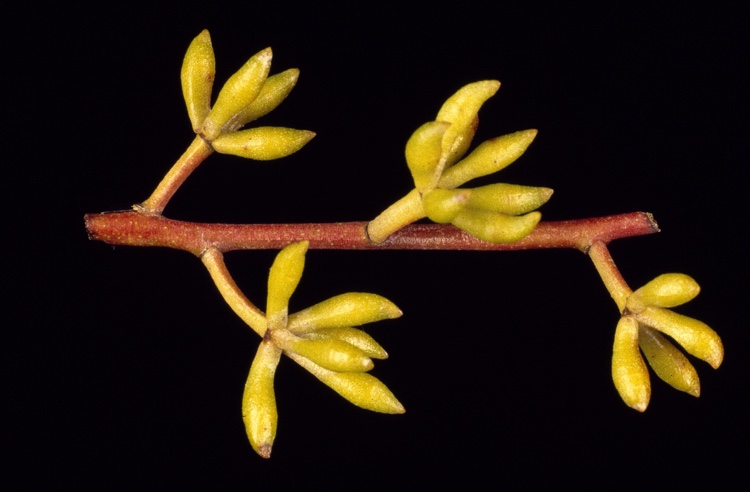Eucalyptus Mckieana on:
[Wikipedia]
[Google]
[Amazon]
''Eucalyptus mckieana'', commonly known as McKie's stringybark, is a species of tree that is 

endemic
Endemism is the state of a species being found in a single defined geographic location, such as an island, state, nation, country or other defined zone; organisms that are indigenous to a place are not endemic to it if they are also found elsew ...
to New South Wales
)
, nickname =
, image_map = New South Wales in Australia.svg
, map_caption = Location of New South Wales in AustraliaCoordinates:
, subdivision_type = Country
, subdivision_name = Australia
, established_title = Before federation
, es ...
. It has rough, stringy bark on the trunk and branches, lance-shaped to curved adult leaves, flower buds in groups of between seven and eleven, white flowers and cup-shaped, barrel-shaped or hemispherical fruit.

Description
''Eucalyptus mckieana'' is a tree that typically grows to a height of and forms a lignotuber. It is usually straight-trunked with reddish brown stringy or fibrous bark on the trunk to the ends of the branches. Young plants and coppice regrowth have stems that are more or less square in cross-section, and leaves that are egg-shaped at first, later narrow lance-shaped, long and wide on a short petiole. Adult leaves are lance-shaped to curved, the same shade of glossy green on both sides, long and wide on a petiole long. The flower buds are arranged in groups of seven, nine or eleven in leaf axils on an unbranched peduncle long, the individual buds onpedicels
In botany, a pedicel is a stem that attaches a single flower to the inflorescence. Such inflorescences are described as ''pedicellate''.
Description
Pedicel refers to a structure connecting a single flower to its inflorescence. In the absenc ...
long. Mature buds are oval to spindle-shaped, long and about wide with a conical operculum. Flowering has been recorded in April and July and the flowers are white. The fruit is a woody cup-shaped, barrel-shaped or hemispherical capsule long and wide with the valves near rim level.
Taxonomy and naming
''Eucalyptus mckieana'' was first formally described in 1930 byWilliam Blakely
William Faris Blakely (November 1875 – 1 September 1941) was an Australian botanist and collector. From 1913 to 1940 he worked in the National Herbarium of New South Wales, working with Joseph Maiden on ''Eucalyptus'', Maiden named a ''red g ...
in ''Proceedings of the Linnean Society of New South Wales
The Linnean Society of New South Wales promotes ''the Cultivation and Study of the Science of Natural History in all its Branches'' and was founded in Sydney, New South Wales ( Australia) in 1874 and incorporated in 1884.
History
The Society suc ...
'' from specimens collected on the upper part of the Gwydir River. The specific epithet
In taxonomy, binomial nomenclature ("two-term naming system"), also called nomenclature ("two-name naming system") or binary nomenclature, is a formal system of naming species of living things by giving each a name composed of two parts, bot ...
honours " Ernest Norman McKie, B.A., Presbyterian Minister at Guyra, N.S.W., who, by his intimate field and botanical knowledge of the New England Eucalypts, has helped in the elucidation of this and other species of this most economic genus."
Distribution and habitat
McKie's stringybark grows in dry forest on low hills and gentle slopes on the drier western side of the New England Tableland between Torrington andBendemeer
Bendemeer () is a village of 485 people on the Macdonald River in the New England region of New South Wales, Australia. It is situated at the junction of the New England and Oxley Highways. Bendemeer is also famous for producing the number on ...
.
Conservation status
This eucalypt is classified as "vulnerable" under the Australian Government '' Environment Protection and Biodiversity Conservation Act 1999'' and the New South Wales Government '' Biodiversity Conservation Act 2016''. Although some populations are conserved in a national park and nature reserve, most occur on private property. The main threats to the species include land clearing, timber harvesting, firewood collection and road works.See also
* ''Eucalyptus'' × ''tinghaensis'', believed to be a hybrid of ''E.'' ''caliginosa'' and possibly ''E. mckieana''.References
{{Taxonbar, from=Q15397603 mckieana Myrtales of Australia Flora of New South Wales Trees of Australia Plants described in 1934 Taxa named by William Blakely